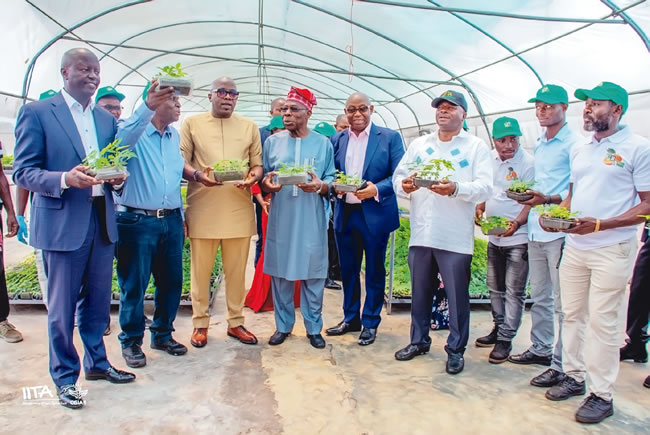On August 24, 2022, after visiting President Felix-Antonio Tshisekedi of the Democratic Republic of Congo, (DRC) Nigeria’s former president, Olusegun Obasanjo, was driven to the outskirts of DRC’s capital, Kinshasa. It was a vast land that serves as the DRC tissue culture facility of the International Institute of Tropical Agriculture (IITA) which has its headquarters in Ibadan, Oyo State. This swath of land was where the institute incubates a partnership it recently struck with the DRC government.
Obasanjo must have felt nostalgic. As he was shown round the templates of that partnership – the model greenhouse planting of cassava, citrus and other crops that are in the agenda of the DRC-IITA partnership, jointly financed by the government and the African Development Bank – (AfDB) each step taken by that delegation on the visit ostensibly increased Obasanjo’s nostalgia.
Between 2011 and 2015, Nigeria pioneered that model partnership with the “agric transformation agenda” it conceived with IITA. With Dr. Akinwumi Adesina, an ex-scientist at the IITA, as Nigeria’s Minister of Agriculture, DRC’s recent agricultural transformation agenda as solution to its youth restiveness and turning this largest country in Africa into what economists call a “basket case” had its roots in the Nigerian experience. During that period in Nigeria, in partnership with same IITA and great support from President Goodluck Jonathan, the parties proved to the world that it is doable to partner with an international agency in rapidly increasing agricultural productivity. That agenda died a natural death with the exit of Jonathan as President and Adesina as Minister.
From available data, the result of that Nigeria-IITA partnership was spectacular. Statistics showed that, between 2011 and 2014, national food production increased by 21 million tons of food, leading to a sharp reduction in food imports. According to the data, “Nigeria’s food bill of import rose from a record high of 3.19 trillion naira ($8.4 billion) in 2011 to 635 billion naira ($1.7 billion) in 2013; a reduction of 40.3%. Direct agricultural jobs increased by 3.56 million during the period 2012-2014” due to this partnership and interventions.
Beginning from the Obasanjo Fourth Republic era, agriculture was given a prime place of governmental consideration and made to become an exciting sector in Nigeria. It was this Nigerian model of 2011-2015 that the DRC studied and learnt from, with the hope of harnessing the resources of its farmers across the country. The ultimate goal is delivering “a green revolution that will make DRC self-sufficient in food production… transform DRC into a breadbasket, a central power for food production.” DRC gave itself the task of making a fundamental paradigm shift which will make agriculture a business and not a development program; structure it, get it developed, resourced and financed as a business. Its mantra is that the days of treating agriculture as a development project were over.
In 2022, the DRC President, Tshisekedi, merely asked that that programme, rechristened the Agricultural Transformation Agenda of DRC, otherwise known as ATA-DRC program, be reinvigorated in his country. It is being implemented by IITA, in close collaboration with key partners in the public and private sectors. Its outlay is huge, spanning an operational base in 145 territories within DRC.
Though IITA is based in Ibadan, its Director General, Dr. Nteranya Sanginga, is a Congolese. In over eleven years of his directorship of IITA, he has expanded the coast of the institute in major countries of Africa and partnering governments for a sustainable agriculture on the continent. An agricultural research and development expert, his areas of specialization are in applied microbial ecology, plant nutrition, and integrated natural resources management which he has demonstrated while working in Africa, Latin America, and Southeast Asia. Sanginga had earlier worked with the University of Zimbabwe, International Atomic Energy Agency in Austria, and Tropical Soil Biology and Fertility Institute of CIAT. Before joining IITA as Director General, he was the executive director of CIAT-TSBF from 2003 to 2011.
This will become part of the arsenal of development actions slated to be carried out for a five-year term, 2023-2028. This vision of the DRC government in this programme is for IITA to “focus on agricultural value chains where DRC has a comparative advantage; agriculture as a business and not a development program; development of strategic partnerships to stimulate market-oriented investments involving the revision of the agricultural code on the model of Kenya and Nigeria; ensure food security and creation of wealth and jobs with emphasis on youth and women; invest more in education and agricultural research by reforming INERA into a national agency for agricultural transformation responding to the Ministry of Agriculture and creation of agricultural inspection squad to carry out monitoring and evaluation.”
Both the DRC government and IITA are convinced that the ATA-DRC agenda will revolutionize agriculture in the country. They are persuaded, in the words of IITA, that the project will “grow and transform the agriculture sector into a business that works for small, medium and large farmers, which will unlock wealth and enable DRC to meet its food needs, while becoming a major player in African and global food markets, to help diversify income for the country.”
On how IITA will achieve this, the institute said it had already launched agricultural transformation plans for the main commodities that DRC used to have renown for, with the support of AfDB, World Bank and International Fund for Agricultural Development, (IFAD) the latter being an international financial institution and a specialized agency of the United Nation. IITA said it will focus first on accelerating food production in DRC, to meet the four needs of the Congolese and reduce the cost of food in the country.
According to the institute, its route to achieving this in DRC is to launch a green revolution plan for rice, cassava, banana/plantain, beans and soybeans in some provinces of the country, which it had already begun. It also plans to cultivate more than 45,000 hectares of these crops and will revamp DRC’s coffee, tea, cocoa and oil palm sectors and regain the glory lost in those commodities.
“We are going to re-launch the production of horticulture, market garden vegetables, onions and tomatoes. We have also targeted the important areas of improving production and markets for livestock, fisheries and aquaculture,” it said.
Already, to operationalize this programme, the institute has divided DRC into four groups. The first includes territories which have more than 100,000 inhabitants and with less than four hours acceptable market accessibility. This will facilitate trade in agricultural inputs and products.
Aware that President Tshisekedi was particularly bothered about the project attracting jobs to the unemployed youth and women of DRC, IITA’s estimated the jobs to be created from the ATA-DRC project by adopting the usage of coefficients. For instance, it estimates a ton of product for one job to be created for rice and oil palm and two tons per one job created for cassava, maize, soybeans, beans and cassava.
“This coefficient is an average that includes all activities along the value chain after primary production. The return on investment is the ratio of the amount of investments to the value of total production to get an idea of the profitability of investments with a ratio that must be greater than 1. The average value obtained for each indicator by speculation and by territory was extrapolated to the 145 territories.
“As a result, we adopted an assumption that the maximum number of territories for a speculation was limited to 100 territories. The current performance results did not take into account livestock or vegetable crops. For cassava, only the roots were taken into consideration in the analysis and not the cassava leaves, which are the first vegetable consumed by households in DRC,” it said.
IITA focuses on crops like cassava, rice, corn/soya, beans, plantain/banana, etc, fish and livestock support for agricultural production (machinery and production tools for improving production conditions through mechanization; agricultural inputs. It also zeroes in on livestock, workshop for manufacturing accessories for mechanization equipment in agriculture associated with tractors which it considered for four agricultural equipment accessory manufacturing centers like Kalambo in South Kivu of DRC, Kisangani and INERA Yangambi, Mbujimayi and Ngandajika; Kinshasa and Mvuazi and also in the installations of private oil mills in the country.
ALSO READ FROM NIGERIAN TRIBUNE
The ATA-DRC programme is also factoring in youth, as well as strengthening women’s economic empowerment skills and entrepreneurship development. This it is doing by training women, youth and other local entrepreneurs to produce new food products from products such as bread, cakes, donuts, etc.). It believes that this will catalyze women and youth-owned SMEs in rural areas
Adesina’s AfDB is massively involved in the ATA-RDC initiative. It does this by making available resources for the project, in collaboration with the Congolese government. By contributing immensely to its funding from its own resources and partnering with a reputable institution like IITA, the DRC government is sending a strong signal about its seriousness in agriculture and its resolve in achieving huge impacts in agriculture.
Since the first week of February 2022, IITA has begun a massive deployment of its operations towards making the ATA-DRC a model of success in Africa. Already, it has installed its stations and antennas throughout the country – Kalambo in South Kivu, Kisangani and INERA Yangambi, Mbujimayi and Ngandajika; Kinshasa and Mvuazi and also conducted the installation of private oil mills of Congo’s former PLC, Digila with UAP Agro-Pastoral Uélé).
Also, it has since implemented quick impact actions like the acquisition of seeds, cuttings and other agricultural inputs which have been deployed in the 145 territories of the country. It is also optimizing the benefit already obtained in the cassava sector, especially in South Kivu and Tanganyika, and now supplementing this with provision of facilities for livestock feed production chains that boost pig, chicken and table egg farms. The institute again went ahead to install 500 hectares of cassava cultivation in Mbandaka, activating the installation of a cassava processing line for the making of bread flour, the Congolese staple called fufu and animal feeds for the Kinshasa market.
As Obasanjo was conducted round the IITA tissue culture facility in Kinshasa this day in August, 2022, he most certainly would have wished that this revolution was taking place in his home country, Nigeria again.
WATCH TOP VIDEOS FROM NIGERIAN TRIBUNE TV
- Let’s Talk About SELF-AWARENESS
- Is Your Confidence Mistaken for Pride? Let’s talk about it
- Is Etiquette About Perfection…Or Just Not Being Rude?
- Top Psychologist Reveal 3 Signs You’re Struggling With Imposter Syndrome
- Do You Pick Up Work-Related Calls at Midnight or Never? Let’s Talk About Boundaries








